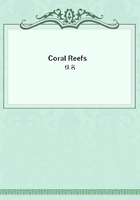
第88章
SAHIA DE MALHA bank consists of a series of narrow banks, with from eight to sixteen fathoms on them; they are arranged in a semicircular manner, round a space about forty fathoms deep, which slopes on the S.E. quarter to unfathomable depths; they are steep-to on both sides, but more especially on the ocean-side. Hence this bank closely resembles in structure, and I may add from Captain Moresby's information in composition, the Pitt's Bank in the Chagos group; and the Pitt's Bank, must, after what has been shown of the Great Chagos Bank, be considered as a sunken, half-destroyed atoll; hence coloured blue.--CARGADOS CARAJOS BANK. Its southern portion consists of a large, curved, coral-shoal, with some low islets on its eastern edge, and likewise some on the western side, between which there is a depth of about twelve fathoms. Northward, a great bank extends. I cannot (probably owing to the want of perfect charts) refer this reef and bank to any class;--therefore not coloured.--ILE DE SABLE is a little island, lying west of C. Carajos, only some toises in height ("Voyage of the 'Favourite'," volume i., page 130); it is surrounded by reefs; but its structure is unintelligible to me. There are some small banks north of it, of which I can find no clear account.--MAURITIUS. The reefs round this island have been described in the chapter on fringing-reefs; coloured red.
--RODRIGUEZ. The coral-reefs here are exceedingly extensive; in one part they project even five miles from the shore. As far as I can make out, there is no deep-water moat within them; and the sea outside does not deepen very suddenly. The outline, however, of the land appears to be ("Life of Sir J. Makintosh," volume ii., page 165) hilly and rugged. I am unable to decide whether these reefs belong to the barrier class; as seems probable from their great extension, or to the fringing class; uncoloured.
--BOURBON. The greater part of the shores of this island are without reefs; but Captain Carmichael (Hooker's "Bot. Misc.") states that a portion, fifteen miles in length, on the S.E. side, is imperfectly fringed with coral reefs: I have not thought this sufficient to colour the island.
SEYCHELLES.
The rocky islands of primary formation, composing this group, rise from a very extensive and tolerably level bank, having a depth between twenty and forty fathoms. In Captain Owen's chart, and in that in the "Atlas of the Voyage of the 'Favourite'," it appears that the east side of MAHE and the adjoining islands of ST. ANNE and CERF, are regularly fringed by coral-reefs.
A portion of the S.E. part of CURIEUSE Island, the N., and part of the S.W. shore of PRASLIN Island, and the whole west side of DIGUE Island, appear fringed. From a MS. account of these islands by Captain F. Moresby, in the Admiralty, it appears that SILHOUETTE is also fringed; he states that all these islands are formed of granite and quartz, that they rise abruptly from the sea, and that "coral-reefs have grown round them, and project for some distance." Dr. Allan, of Forres, who visited these islands, informs me that there is no deep water between the reefs and the shore. The above specified points have been coloured red. AMIRANTES Islands: The small islands of this neighbouring group, according to the MS. account of them by Captain F. Moresby, are situated on an extensive bank; they consist of the debris of corals and shells; are only about twenty feet in height, and are environed by reefs, some attached to the shore, and some rather distant from it.--I have taken great pains to procure plans and information regarding the several islands lying between S.E. and S.W. of the Amirantes, and the Seychelles; relying chiefly on Captain F. Moresby and Dr. Allan, it appears that the greater number, namely--PLATTE, ALPHONSE, COETIVI, GALEGA, PROVIDENCE, ST. PIERRE, ASTOVA, ASSOMPTION, and GLORIOSO, are low, formed of sand or coral-rock, and irregularly shaped; they are situated on very extensive banks, and are connected with great coral-reefs. Galega is said by Dr. Allan, to be rather higher than the other islands; and St. Pierre is described by Captain F. Moresby, as being cavernous throughout, and as not consisting of either limestone or granite. These islands, as well as the Amirantes, certainly are not atoll-formed, and they differ as a group from every other group with which I am acquainted; I have not coloured them; but probably the reefs belong to the fringing class. Their formation is attributed, both by Dr. Allan and Captain F. Moresby, to the action of the currents, here exceedingly violent, on banks, which no doubt have had an independent geological origin. They resemble in many respects some islands and banks in the West Indies, which owe their origin to a similar agency, in conjunction with an elevation of the entire area. In close vicinity to the several islands, there are three others of an apparently different nature: first, JUAN DE NOVA, which appears from some plans and accounts to be an atoll; but from others does not appear to be so; not coloured. Secondly COSMOLEDO; "this group consists of a ring of coral, ten leagues in circumference, and a quarter of a mile broad in some places, enclosing a magnificent lagoon, into which there did not appear a single opening"
(Horsburgh, volume i., page 151); coloured blue. Thirdly, ALDABRA; it consists of three islets, about twenty-five feet in height, with red cliffs (Horsburgh, volume i., page 176) surrounding a very shallow basin or lagoon. The sea is profoundly deep close to the shore. Viewing this island in a chart, it would be thought an atoll; but the foregoing description shows that there is something different in its nature; Dr.
Allan also states that it is cavernous, and that the coral-rock has a vitrified appearance. Is it an upheaved atoll, or the crater of a volcano?--uncoloured.
COMORO GROUP.